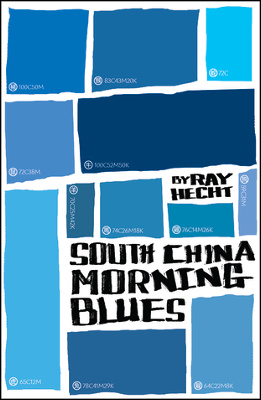|
by Kathy Wong

Ray Hecht, South China Morning Blues, Blacksmith Books, 2015. 352 pgs. South China Morning Blues is Ray Hecht's debut novel and revolves around expatriates living in the Pearl River Delta region where Hong Kong, Shenzhen and Guangzhou are situated. Compared to Shanghai and Beijing, Guangzhou and Shenzhen have been less written about in literary works in English. Even when the Pearl River Delta region has been featured, it often serves as a historical backdrop for the political vicissitudes of the early 20th century. Yet, Hecht's novel shines a spotlight on contemporary Guangzhou and Shenzhen, together with Hong Kong, which are becoming more popular for expatriates looking for a piece of the Chinese Dream. Hecht avoids the clichéd portrayal of the challenges and difficulties faced by expats abroad; instead, with carefully crafted storytelling featuring multiple voices, he leads us through interlocking narratives which depict what life is really like when foreigners are immersed in the Southern Chinese world of the 21st century. Hecht, who has lived in China for several years, makes use of personal experiences, hearsay, research and his own imagination to create a novel about young expatriates and local Chinese as they struggle and find their way through hardship and temptation. The novel is divided into three sections, Shenzhen, Guangzhou and Hong Kong. Each of the three cities depicted by Hecht exudes its own unique idiosyncratic features—Shenzhen, the fast-changing and westernising metropolis; Guangzhou, the traditional capital striving for rejuvenation and globalisation; Hong Kong, the hedonistic and frustrated modern gateway between East and West. But the differences between the cities lie not only in the textures of their cityscapes and geopolitical positions, but also in how social relations between locals and foreigners are interwoven. As hinted at by the title of the novel, South China Morning Blues is filled with the different sorts of 'blues' faced by expatriates in the three cities, such as language barriers, cultural shocks and biases, as well as dark moments to do with casual hook-ups, prostitution and alcohol and drug abuse. Hecht strategically sheds light on life in the region by adopting a multifaceted narrative mode: he creates a chain of interlocking stories told by a dozen narrators. Twelve sets of subjective experiences related to expatriate communities are represented—not only foreigners from different cultural backgrounds are given a voice, but local Chinese residents, including those who do not speak much English, are also heard. Interestingly, each of these characters is assigned one of the twelve Chinese zodiac signs at the beginning of the novel, and as the story progresses, each is signified by his or her zodiac sign rather than their real name. This intriguing conceit creates a sense that twelve anonymous and universal archetypes are interwoven to form a coherent narrative. The novel starts with a nightclub encounter, followed by a one-night stand between Marco, an American expatriate businessman, and Sheila, a local Chinese woman, in Shenzhen. In this episode, rather than giving detailed sensual descriptions from the foreigner's perspective, Hecht switches between the two characters' viewpoints. There is not much actual dialogue between them; instead, Marco and Sheila each reveal their own unspoken thoughts: 兔 [Hare, representing Sheila] The sex feels okay. I like the style of his home. It's very big and neat. I suppose that a cleaning lady must come here every day. What did he say his job is? I didn't understand. 虎 [Tiger, representing Marco] The sex feels awesome. I'm so turned on that I'm going to cum any second. She's skinny, no ounce of fat on her. I love that flat stomach. She didn't put up any resistance. Totally into it! Goddamn, I still have the charm! Switching perspectives in this fashion not only creates a swift and breathless rhythm for the erotic encounter, but also functions as a tool to juxtapose two sets of competing opinions. Indeed, this experimental narrative mode is what makes the novel so original. Through this storytelling technique, Hecht invents alternative spaces in which individuals' candid judgments, if not biases, are revealed. Hecht's attempt at presenting the diversity of the Pearl River Delta in South China Morning Blues is overt: it can be observed from the fact that the novel brings to light local perspectives which are often absent in expatriate writings. One example is the story of Lu Lu, Sheila's cousin. Not able to speak much English, Lu Lu represents those who are supposedly invisible to the expatriate community. In the story, depicted as being motivated by the Chinese social norm to get married, the characterisation of Lu Lu seems to conform to the traditional stereotype of the submissive Chinese female. Still, this character does reflect the reality of modern China: even though the country is more exposed to Western influences and while there is undoubtedly a growing number of women like Sheila, who have more freedom to explore their own sexualities and aspirations, stories like Lu Lu's remain common. This character reminds us that women bound by traditions are found not only in remote rural areas of the country but also in metropolitan centres like Shenzhen and Guangzhou. South China Morning Blues offers a collective memory shared by expatriates in the Pearl River Delta region. At the same time, it also brings to light local Chinese realities in which other shades of blue are found. |